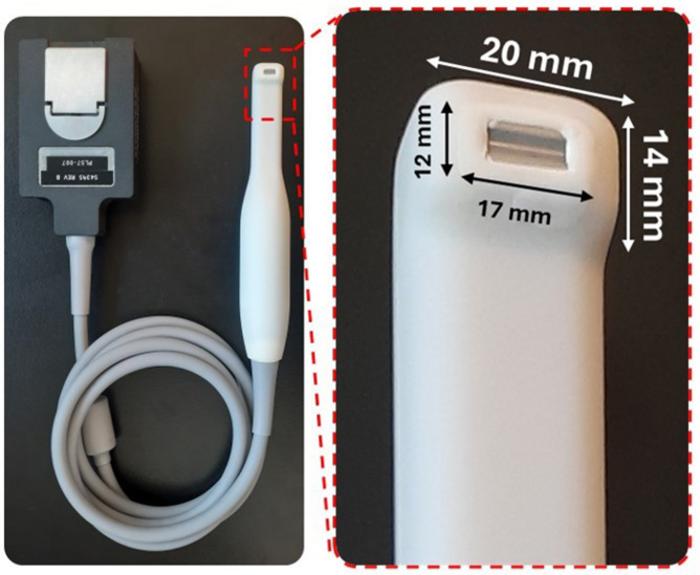A groundbreaking development in dental diagnostics promises to revolutionize the way gum disease is detected and monitored. Traditional periodontal probing, a method that involves manually prodding the gums with a thin metal instrument to assess gum health, is often uncomfortable and limited in its ability to detect early signs of disease. However, a team of researchers has unveiled a novel toothbrush-shaped ultrasound transducer that offers a minimally invasive, high-resolution alternative to this widely used practice. This innovative device, detailed in a forthcoming publication in ACS Sensors, could change the face of dental care by enabling precise imaging of teeth and gums, including hard-to-reach areas at the back of the mouth.
Gum disease, medically known as periodontitis, affects the tissues that surround and support the teeth. As the disease progresses, the gums recede, creating pockets that harbor harmful bacteria capable of causing further oral damage and systemic health complications. Early detection is critical, yet current diagnostic tools like periodontal probes often cause discomfort and may fail to identify subtle, initial changes in gum tissues. Recognizing these limitations, the team led by Jesse Jokerst set out to design a device that merges the non-invasive imaging capabilities of ultrasound with the appropriate miniaturization necessary for oral applications.
Ultrasound imaging operates by emitting high-frequency sound waves into the body, which are reflected back upon encountering different tissue interfaces. These reflected waves are then captured and interpreted by the transducer to generate detailed images of internal structures. Conventional ultrasound transducers tend to feature large heads roughly equivalent to the size of wireless earbud cases, making them unsuitable for intraoral use, particularly in the confined spaces surrounding molars and premolars. Although smaller transducers exist, they typically function at lower frequencies and yield poorer resolution images, rendering them suboptimal for detailed periodontal assessment.
To address these challenges, Jokerst’s team engineered a miniaturized ultrasound transducer shaped like a toothbrush, with a compact head capable of navigating the intricate contours of the mouth. This design not only facilitates access to posterior teeth but also operates at enhanced frequencies to generate high-fidelity images of gum and tooth structures. The device’s ability to image these areas with improved resolution provides unprecedented insight into tissue thickness and morphology, which are vital indicators of periodontal health.
The research team rigorously tested the performance of this ultrasound transducer in proof-of-concept experiments using pig teeth, chosen as an analog for human oral anatomy. They measured parameters such as gum thickness and height with the device and compared these readings to those acquired through traditional manual probing. Statistical analyses showed that the ultrasound measurements paralleled manual probe data closely, affirming that the new tool’s accuracy matches established clinical standards while offering greater patient comfort.
One of the principal advantages of the toothbrush-shaped transducer is its non-invasive nature. Unlike the discomfort commonly reported during periodontal probing, the ultrasound device scans the gums without breaking the surface, reducing patient anxiety and improving the feasibility of frequent monitoring. Furthermore, the high-resolution images facilitate early detection of gum disease, potentially prompting timely interventions that can prevent disease progression and the subsequent need for invasive treatment.
The implications of this technology extend beyond diagnostics. Detailed imaging below the gumline can enable clinicians to monitor healing after treatments such as scaling and root planing, implants, or periodontal surgery. By repeatedly assessing the same sites non-invasively, dental professionals could tailor treatments dynamically and track patient responses in real time. This capability holds promise for elevating the standard of personalized dental care.
From a technical standpoint, the researchers overcame significant engineering obstacles in producing a transducer that balances size, frequency, and image quality. Smaller transducers often suffer from limited frequency bandwidth, which diminishes resolution and depth penetration. The novel device, however, achieves a frequency spectrum that supports the resolution necessary for detailed imaging of soft and hard oral tissues, despite its miniature form factor. Its toothbrush-like architecture also ensures ergonomic handling akin to everyday dental hygiene tools.
Looking forward, the research team plans to transition this ultrasound transducer from preclinical testing to human trials. Integrating the device into routine dental exams could transform oral healthcare by supplementing or eventually replacing manual probing. Since it offers a painless, reliable means to detect early disease, it might encourage more individuals to seek regular periodontal screening and improve overall oral health outcomes.
Moreover, the technology has the potential to interface with advanced imaging software and artificial intelligence to automatically analyze ultrasound data, flagging areas of concern for dental professionals. Such integration could streamline clinical workflows and enhance diagnostic precision, driving efficiencies in dental practice and potentially reducing healthcare costs associated with untreated gum disease.
The development of the toothbrush-shaped ultrasound transducer underscores a broader trend in medical device innovation: miniaturization combined with high performance to meet the practical demands of specific clinical environments. By drawing inspiration from familiar objects—like the toothbrush—the researchers ensured the device’s design would be both functional and intuitive, helping to speed adoption in dental clinics.
This research was supported by the National Institutes of Dental and Craniofacial Research under the National Institutes of Health, highlighting the commitment of public agencies to foster technologies that improve health outcomes. As this novel ultrasound device moves closer to clinical implementation, it embodies a promising leap forward in dental diagnostics, patient comfort, and preventive medicine.
In summary, the toothbrush-shaped ultrasound transducer represents a significant advancement in periodontal imaging technology. It offers a miniaturized, high-frequency, and patient-friendly alternative to manual probing, capable of accessing the entire oral cavity with exceptional image quality. Its potential to diagnose gum disease earlier and monitor treatment response non-invasively could lead to better oral health and reduced incidence of advanced periodontitis, signaling a new era in dental care.
Subject of Research: Miniaturized ultrasound transducer for periodontal imaging
Article Title: “Performance Evaluation of a Miniaturized Toothbrush-shaped Ultrasound Transducer for Periodontal Imaging”
News Publication Date: 26-May-2025
Web References:
http://dx.doi.org/10.1021/acssensors.5c00521
References:
Adapted from ACS Sensors 2025, DOI: 10.1021/acssensors.5c00521
Image Credits:
Credit: Adapted from ACS Sensors 2025, DOI: 10.1021/acssensors.5c00521
Keywords
Chemistry, Health and Medicine, Dentistry




